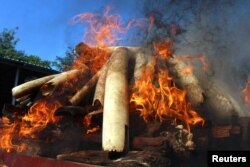Some three tons of African ivory sat in an unmarked crate in a Cambodian port for more than a year, until a tip from the U.S. embassy led authorities to break it open this week and discover the country's largest-ever haul of trafficked ivory.
Port laborers who recently gathered outside the facility told a reporter that no one had ever showed up to claim the valuable cargo.
"There are 12 containers and one container consists of elephants tusks packed in sacks and some sacks loading rocks which look like marble," said a laborer who witnessed the seizure at the Phnom Penh Autonomous Port Container Terminal on Thursday last week.
He asked not to be named since he is afraid of being identified by port authorities.
"I think they [authorities] wanted to know [who] the owner is, but perhaps the owner knew and didn't appear," added the laborer.
A smartphone photograph provided by the worker shows hundreds of elephant tusks, some cut in two, sitting on a cement floor near the containers.
U.S. tips lead to seizure
Emily Zeeberg, the U.S. Embassy spokesperson, said American officials provided information to the Cambodian Customs and Excise Department that ultimately led to the search of a sealed container and to the seizure of 1,026 cut and whole pieces of ivory weighing approximately 3,370 kilograms.
"The ivory originated from Mozambique. Cambodia is a transit hub; there is no information indicating that the ivory was intended to be sold here in Cambodia," she said in an email. "The investigation is ongoing."
Ros Vanna, chairman and CEO of Kampuchea Shipping Agency and Brokers, also known as Kamsab, which grants customs clearance to foreign ships, said the port does not have rights to open the sealed containers immediately if the owner does not come. He said if goods are abandoned, a court must intervene.
"The owner didn't appear to take [them] and then we sued to the court and open the containers," he said.
Sun Chhay, a director of the Customs and Excise Office at the port, told VOA Khmer that the owner of the containers apparently did not show up to claim the cargo because they feared the smuggling operation had been exposed.
"So far we don't know whether the owner is Cambodian or foreigner," he said.
Chhay confirmed that the ivory was imported from Mozambique and shipped through Vietnam, where he said it was not checked because that country's customs authority does not have the rights to check transiting cargo.
He added that the next actions should be decided by his superior official.
Kun Nhim, general director of the General Department of Customs and Excise could not be reached for comment.
Ivory trade in Cambodia is 'booming'
In December 2017, Cambodian authorities seized around 270 tusks at Cambodia's southwestern port of Sihanoukville. In 2016, the country's authorities also seized around 1.5 tons of ivory kept in containers in Phnom Penh and in 2014 Cambodian customs officials seized some 3 tons of African ivory in Sihanoukville as well.
Paul Chambers, a political analyst at the College of Asean Community Studies at Naresuan University in Thailand, said Cambodia could be both a source and a transit country for the tusks.
"Cambodia has been an easy place to practice the international ivory trade because government enforcement is relatively lax," he said. "Where there is money to be made, there will be buyers. That is what accounts for the continuing booming ivory trade in Cambodia or elsewhere in the world. The destination could be anywhere in the world, but it is so tragic that this trade continues," he added.
Meas Nee, a political analyst, said complex operations like ivory smuggling typically involve powerful people in Cambodia, even if the tusks are headed elsewhere.
"I think Cambodia is just a transit only since we don't really have law enforcement and there is also corruption as well," he added.
Save the Elephants, a UK-registered charity headquartered in Nairobi, issued new research in October this year, saying that Myanmar's illegal ivory trade has been growing, with more exports headed to China.
The whole sale price for African raw ivory in late 2017 in the Golden Triangle region has remained stable at about $770 to $800 per kg since late 2015, according to Save the Elephants. Approximately 100,000 elephants in Africa were killed for their ivory in just three years between the years 2010 and 2012.
Between 20,000 and 30,000 African elephants are killed each year, according to the World Wildlife Fund









